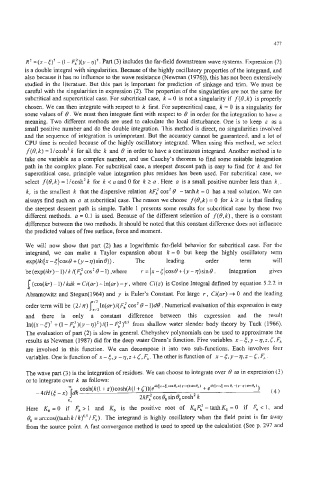Page 502 - Practical Design Ships and Floating Structures
P. 502
477
R’ = (x - 5)’ + (1 - F,Z)(y - q)’. Part (3) includes the far-field downstream wave systems. Expression (2)
is a double integral with singularities. Because of the highly oscillatory properties of the integrand, and
also because it has no influence to the wave resistance (Newman (1976)), this has not been extensively
studied in the literature. But this part is important for prediction of sinkage and trim. We must be
careful with the singularities in expression (2). The properties of the singularities are not the same for
subcritical and supercritical case. For subcritical case, k = 0 is not a singularity if f(8,k) is properly
chosen. We can then integrate with respect to k first. For supercritical case, k = 0 is a singularity for
some values of 8. We must then integrate first with respect to 8 in order for the integration to have a
meaning. Two different methods are used to calculate the local disturbance. One is to keep E as a
small positive number and do the double integration. This method is direct, no singularities involved
and the sequence of integration is unimportant. But the accuracy cannot be guaranteed, and a lot of
CPU time is needed because of the highly oscillatory integrand. When using this method, we select
f(e,k) = I/cosh2 k for all the k and B in order to have a continuous integrand. Another method is to
take one variable as a complex number, and use Cauchy’s theorem to find some suitable integration
path in the complex plane. For subcritical case, a steepest descent path is easy to find for k and for
supercritical case, principle value integration plus residues has been used. For subcritical case, we
select f(8,k) = l/cosh2 k for k < a and 0 for k 2 a. Here a is a small positive number less than k, .
k, is the smallest k that the dispersive relation kF2 cos2 B - tanh k = 0 has a real solution. We can
always find such an a at subcritical case. The reason we choose f(8,k) = 0 for X 2 a is that finding
the steepest descent path is simple. Table 1 presents some results for subcritical case by these two
different methods. a = 0.1 is used. Because of the different selection of f(B, k) , there is a constant
difference between the two methods. It should be noted that this constant difference does not influence
the predicted values of free surface, force and moment.
We will now show that part (2) has a logarithmic far-field behavior for subcritical case. For the
integrand, we can make a Taylor expansion about k = 0 but keep the highly oscillatory term
exp(ik(lx-5]cosB+(y-q)sinB)). The leading order term Will
be(exp(ikr)-l)/k/(F,cos*B-l) ,where r = Ix-51cosB+(y-v)sinB. Integration gives
1 (cos(kr) - 1) / kdk = Ci(ur) - ln(ar) - y , where Ci(z) is Cosine Integral defined by equation 5.2.2 in
Abramowitz and Stegun(1964) and y is Euler’s Constant. For large r , Ci(ar) + 0 and the leading
order term will be (21n) ln(ar)/(Fi cos2 B - l)d8. Numerical evaluation of this expression is easy
and there is only a constant difference between this expression and the result
ln((x - 4)’ + (1 - Fi)(y - 7)’) (1- F;)”’ from shallow water slender body theory by Tuck (1966).
The evaluation of part (2) is slow in general. Chebyshev polynomials can be used to approximate the
results as Newman (1987) did for the deep water Green’s function. Five variables x - 4.y - q,z,<, Fh
are involved in this function. We can decompose it into two sub-functions. Each involves four
variables. One is functionof x-(,y-~,z+(,F,. Theother is functionof x-{,y-%z--c.F,.
The wave part (3) is the integration of residues. We can choose to integrate over 8 as in expression (3)
Here KO = 0 if Fh > 1 and KO is the positive root of KoF; -tanhKo = 0 if Fh < 1, and
eo = arccos((tanh k / k)’ ’ / F,) . The integrand is highly oscillatory when the field point is far away
from the source point. A fast convergence method is used to speed up the calculation (See p. 297 and

